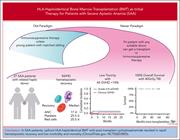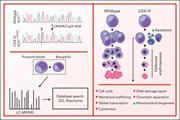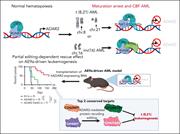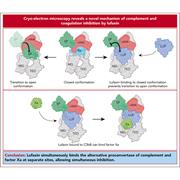Issue Archive
Table of Contents
BLOOD COMMENTARIES
HOW I TREAT
How I treat newly diagnosed and refractory T-cell acute lymphoblastic lymphoma in children and young adults
T-cell lymphoblastic lymphoma (T-LLy) and T-cell acute lymphoblastic leukemia have traditionally been viewed on a spectrum of a single disease, and treatments have been the same. Si Lim and colleagues discuss the ways in which T-LLy behaves like a distinct entity. The authors use a pair of cases to discuss key recommendations for initial therapy, for relapsed disease, and for the role of stem cell transplantation for T-LLy.
CLINICAL TRIALS AND OBSERVATIONS
Alternative donor BMT with posttransplant cyclophosphamide as initial therapy for acquired severe aplastic anemia
Clinical Trials & Observations
DeZern et al report on a phase 2 prospective trial of haploidentical bone marrow transplant (BMT) with posttransplant cyclophosphamide for initial therapy for patients with severe aplastic anemia. With a median follow-up of 40.9 months, survival was 92% with a 4% incidence of chronic graft-versus-host disease. These impressive results, if confirmed in a larger trial, will likely have a major impact on therapeutic algorithms for the treatment of aplastic anemia.
HEMATOPOIESIS AND STEM CELLS
A novel human cellular model of CDA IV enables comprehensive analysis revealing the molecular basis of the disease phenotype
Congenital dyserythropoietic anemia type IV (CDA IV) is caused by mutations in the transcription factor KLF1. CDA IV has been hard to study because the profound anemia and the rarity of the disease impedes acquiring adequate material for study. Ferrer-Vicens and colleagues report on a cellular model of the disease and describe the proteomic profile of the cells, showing widespread disruption of cellular processes associated with a heterozygous patient-derived mutation.
LYMPHOID NEOPLASIA
Baseline PET radiomics outperforms the IPI risk score for prediction of outcome in diffuse large B-cell lymphoma
Clinical Trials & Observations
Eertink and colleagues externally validate the clinical positron emission tomography (PET) assessment developed in the HOVON-84 trial of diffuse large B-cell lymphoma. Based on metabolic tumor volume, maximum distance between the largest lesion and another lesion, and the peak standardized uptake value, clinicalPET successfully predicted the outcomes in 6 independent studies and appeared to perform better than the international prognostic index.
Plasma cell–derived mtDAMPs activate the macrophage STING pathway, promoting myeloma progression
Mitochondrial DNA (mtDNA) is a form of damage-associated molecular patterns (mtDAMPs) that serves as an immune activator. Jibril et al demonstrate that cell-free mtDNA is elevated in the circulation of patients with multiple myeloma (MM) and supports MM cells by facilitating transit to, and retention in, the marrow. High levels of mtDNA promote disease progression. This functional role may offer a novel entry point for anti-MM therapy.
MYELOID NEOPLASIA
Core-binding factor fusion downregulation of ADAR2 RNA editing contributes to AML leukemogenesis
Guo and colleagues investigate the role of adenosine acting on RNA2 (ADAR2), an RNA editing protein, in core binding factor (CBF) acute myeloid leukemia (AML). The authors report that ADAR2 is repressed by the RUNX1-ETO fusion protein in CBF AML and that ADAR2 can repress leukemogenesis in t(8;21) and inv16 AML cells. This finding highlights a novel pathogenetic pathway contributing to the pathogenesis of CBF AML.
RED CELLS, IRON, AND ERYTHROPOIESIS
Macrophage metabolic rewiring improves heme-suppressed efferocytosis and tissue damage in sickle cell disease
Sharma et al investigate how circulating heme contributes to the chronic inflammation of sickle cell disease (SCD). The authors report that heme alters macrophage responses to apoptotic cells, impairing clearance by efferocytosis and reprogramming them toward a pro-inflammatory phenotype, sustaining inflammation. Exposure of macrophages to SCD plasma impairs phagocytosis while hemopexin-mediated heme scavenging improves their function. This heme-triggered perturbation is likely a major contributor to the chronic inflammatory phenotype of SCD.
THROMBOSIS AND HEMOSTASIS
A bispecific inhibitor of complement and coagulation blocks activation in complementopathy models via a novel mechanism
The saliva of blood-feeding arthropods contains inhibitors of both complement and coagulation. Andersen and colleagues present the crystal structure of lufaxin, a sand fly salivary protein, and demonstrate that it binds to both C3b and factor Xa, inhibiting the activity of both. Lufaxin inhibits complement activation in models of atypical hemolytic uremic syndrome and paroxysmal nocturnal hemoglobinuria and also blocks thrombin generation, suggesting that it might be a model for an agent to treat complement-mediated diseases associated with thrombosis.
LETTER TO BLOOD
IPSS-M in myelodysplastic neoplasms arising from aplastic anemia and paroxysmal nocturnal hemoglobinuria
BLOOD WORK
-
Cover Image
Cover Image
![issue cover]()
A congenital dyserythropoietic anemia IV erythroid cell line, generated from BEL-A (Bristol Erythroid Line Adult) cells by introducing the Glu325Lys (E325K) mutation into 1 Krüppel-like factor 1 allele using CRISPR Cas9. The cells, stained with May-Grünwald Giemsa stain, display a proerythroblast and basophilic morphology. Multinuclear proerythroblasts are evident along with plasma membrane blebbing, recapitulating the phenotype of patient erythroid cells. See the article by Ferrer-Vicens et al on page 3039.
- PDF Icon Front MatterFront Matter
- PDF Icon Table of ContentsTable of Contents
- PDF Icon Editorial BoardEditorial Board
Advertisement intended for health care professionals
Email alerts
Advertisement intended for health care professionals











Reward from half a match
Clinical Trials & Observations